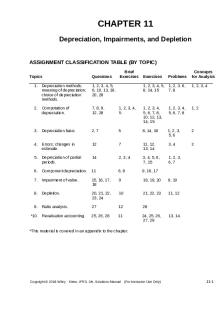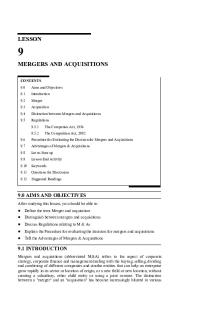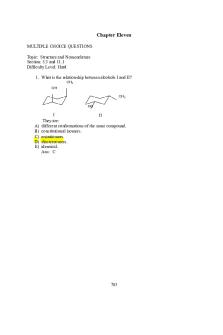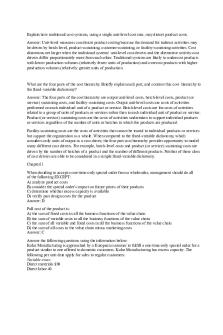Ch11 Making Alliances Acquisitions Work PDF

| Title | Ch11 Making Alliances Acquisitions Work |
|---|---|
| Author | Tong Yuen Shun |
| Course | International Management |
| Institution | University of Manitoba |
| Pages | 10 |
| File Size | 172.3 KB |
| File Type | |
| Total Downloads | 52 |
| Total Views | 159 |
Summary
Download Ch11 Making Alliances Acquisitions Work PDF
Description
Name:
Class:
Date:
ch11: Making Alliances & Acquisitions Work 1. Strategic alliances are voluntary agreements of cooperation between firms. a. True b. False ANSWER: True 2. An acquisition is the combination of operations and management of two firms to establish a new legal entity. a. True b. False ANSWER: False 3. Antitrust authorities are more likely to approve acquisitions as opposed to alliances. a. True b. False ANSWER: False 4. In the context of organizing acquisitions, strategic fit refers to the effective matching of complementary strategic capabilities. a. True b. False ANSWER: True 5. If a firm wants to have some direct control over joint activities on a continuing basis, it should choose an equity relationship over a contractual relationship. a. True b. False ANSWER: True 6. In a three-stage model of alliance formation, firms need to specify a specific format that is either equity based or contractual (non-equity based) in stage three. a. True b. False ANSWER: True 7. The worst scenario for the dissolution of an alliance can be described as "death by 1000 cuts". a. True b. False ANSWER: True 8. The second phase in the dissolution of alliances is going public. a. True b. False ANSWER: True 9. Equity, learning and experience, relational capabilities, and organization are the four factors that may influence alliance performance. Copyright Cengage Learning. Powered by Cognero.
Page 1
Name:
Class:
Date:
ch11: Making Alliances & Acquisitions Work a. True b. False ANSWER: False 10. Equity, learning and experience, nationality, and relational capabilities have each been found to have a direct impact on alliance performance. a. True b. False ANSWER: False 11. Relational capabilities are insignificant in making or breaking alliances. a. True b. False ANSWER: False 12. If a manager is fueled by hubristic motives for acquisition, she may knowingly overpay for targets. a. True b. False ANSWER: True 13. An acquisition is likely to be the largest capital expenditure of a firm, as well as one of its most poorly planned and executed activities. a. True b. False ANSWER: True 14. Inadequate screening is a problem which occurs during the pre-acquisition phase of the merger and acquisitions (M&A) process. a. True b. False ANSWER: True 15. While managing alliances, managers should keep in mind that soft-relationship aspects are secondary to strategic and organizational fit. a. True b. False ANSWER: False 16. _____ are associations between firms that are based on contracts and do not involve the sharing of ownership. a. Non-equity-based alliances b. Acquisitions c. Equity-based alliances d. Competitive alliances ANSWER: a Copyright Cengage Learning. Powered by Cognero.
Page 2
Name:
Class:
Date:
ch11: Making Alliances & Acquisitions Work 17. _____ are based on ownership or financial interest between firms. a. Contractual alliances b. Equity-based alliances c. Acquisitions d. Mergers ANSWER: b 18. Ziff Tech Inc., a technological firm, funds Tictoe Corp., a computer processor designing company, with five percent of its annual revenue. Which of the following best describes the alliance between Ziff Tech and Tictoe Corp.? a. Acquisition b. Strategic investment c. Cross-shareholding d. Merger ANSWER: b 19. _____ refers to a business strategy in which each partner in an alliance holds stock in the other firm. a. Acquisition b. Strategic investment c. Cross-shareholding d. Merger ANSWER: c 20. Ocan Foods Inc., a food and beverage retailer, invests ten percent of its annual revenue in Bright Diaries Inc., a diary manufacturer. Bright Diaries, on the other hand, invests 15 percent of its annual revenue in Ocan Foods. Which of the following equity-based alliances is shown in the given scenario? a. Acquisition b. Contractual alliance c. Cross-shareholding d. Merger ANSWER: c 21. A(n) _____ is a transfer of the control of operations and management from one firm to another. a. strategic investment b. equity-based alliance c. merger d. acquisition ANSWER: d 22. Genra Technologies, a computer manufacturer that specializes in custom-built computers, recently entered into an agreement with Fronton Corp., a computer hardware manufacturer. According to the agreement, the operations and management control of Fronton Corp. will be transferred to Genra Technologies. In addition, Fronton Corp. will be a unit of Genra Technologies. The given scenario is an example of a(n) _____. a. strategic investment b. contractual alliance c. merger Copyright Cengage Learning. Powered by Cognero.
Page 3
Name:
Class:
Date:
ch11: Making Alliances & Acquisitions Work d. acquisition ANSWER: d 23. When two firms combine to establish a new legal entity, it is known as a(n) ______. a. Merger b. Strategic investment c. Contractual alliance d. Acquisition ANSWER: a 24. The wind energy company Cloud Sail and the solar energy company Sun Burst recently formed a new legal entity called Cloud Burst. This action is known as a _____ between the two companies. a. Contractual alliance b. Equity based alliance c. Merger d. Acquisition ANSWER: c 25. Firm A has a very laissez-faire culture of dress and work hours, while Firm B is very regulated and strict in those areas. This difference may prove to be a challenge in which aspect of forming an alliance? a. Strategic fit b. Organizational fit c. Relational capability d. Collaborative capability ANSWER: b 26. Formal institutions influence alliances and acquisitions by: a. requiring firms to conform to the entry mode requirements. b. centering on collective norms, supported by a normative pillar. c. emphasizing internalized values and beliefs, supported by a cognitive pillar. d. emphasizing the creation of value. ANSWER: a 27. Informal institutions affect the formation of alliances and acquisitions by: a. imposing entry mode requirements. b. centering on collective norms, supported by a normative pillar. c. involving antitrust authorities to monitor the market. d. discouraging acquisitions. ANSWER: b 28. A _____ is an investment in real operations as opposed to financial capital. a. real unit b. real option c. real acquisition Copyright Cengage Learning. Powered by Cognero.
Page 4
Name:
Class:
Date:
ch11: Making Alliances & Acquisitions Work d. real expense ANSWER: b 29. In most of the cases, alliances have emerged as great instruments of real options because they help companies to: a. sequentially scale up or scale down their investments. b. choose the right partners for future investments. c. eradicate potential partner opportunism. d. become immune to competition. ANSWER: a 30. In the context of real options, which of the following is a disadvantage of entering into alliances? a. Investments are unlikely to be modified. b. Firms are most likely to choose the wrong partners. c. Alliances with other firms are most likely to fail. d. Entering into alliances is very costly. ANSWER: b 31. Which of the following is true of relational capabilities while managing interfirm relationships? a. They emphasize competition rather than collaboration. b. They foster potential partner opportunism. c. They are covered in the traditional business school curriculum. d. They are rarely found in managers involved in alliances. ANSWER: d 32. In the context of acquisition, the only identifiable group of winners is: a. the shareholders of target firms. b. the shareholders of acquiring firms. c. the employees of acquiring firms. d. the first line managers of target firms. ANSWER: a 33. In the context of organizing acquisitions, _____ is the similarity in culture, systems, and structures between two or more firms. a. strategic fit b. organizational fit c. relational capability d. collaborative capability ANSWER: b 34. In the three-stage model of alliance formation, which of the following is the first stage? a. Taking a decision on the mode of growth b. Making a choice between a contractual and an equity approach c. Selecting an appropriate format to specify the relationship d. Taking decisions on strategic and organizational fits Copyright Cengage Learning. Powered by Cognero.
Page 5
Name:
Class:
Date:
ch11: Making Alliances & Acquisitions Work ANSWER: a 35. Rues and West Bros. manufactures firearms. Since it lacks the skills and high-end technology needed to manufacture silencers for its firearms, it enters into an alliance with Porben Inc., a company that specializes in manufacturing silencers. In order to ensure the optimal utilization of Porben’s technological capabilities, Rues and West Bros. is most likely to follow the _____ approach. a. contractual b. equity c. turnkey project d. licensing ANSWER: b 36. Which of the following approaches does not allow control over joint activities in an alliance? a. The joint venture approach b. The equity approach c. The contractual approach d. The cross-shareholding approach ANSWER: c 37. The party who begins the process of ending an alliance is labeled the _____. a. follower b. partner c. initiator d. retractor ANSWER: c 38. The alliance between Nilesmith Corp. and Pentrall Inc. is set to dissolve. Both the companies are engaged in extensive negotiations with new alliance partners. Which of the following stages of alliance dissolution is shown in the given scenario? a. Going public b. Initiation c. Uncoupling d. Aftermath ANSWER: d 39. A strain between Firm A (an American company) and Firm B (a Saudi Arabian company) was created when Firm B asked the female executives of Firm A to wear headscarves during meetings. Which factor influencing alliance performance is this an example of? a. Hubristic motivation b. Strategic planning c. Relational capacities d. Nationality ANSWER: d 40. According to an institution-based view, which of the following is true of synergistic motives that drive acquisitions? Copyright Cengage Learning. Powered by Cognero.
Page 6
Name:
Class:
Date:
ch11: Making Alliances & Acquisitions Work a. They are a response to formal institutional constraints and transitions. b. They cannot coexist with managerial and hubristic motives. c. They portray self-interested actions guided by informal norms and values. d. They portray overconfidence in one’s capability. ANSWER: a 41. Over a period of ten years, Laelle Corp., a technological firm, has acquired 15 companies. All the acquired companies were high-end technology providers. The company’s intention was to leverage superior resources through these acquisitions. In this scenario, Laelle Corp.’s acquisitions are driven by a(n) _____. a. hubristic motive b. environmental motive c. synergistic motive d. ethical motive ANSWER: c 42. In the context of an institution-based view, which of the following is true of hubristic motives driving acquisitions? a. They are a response to formal institutional constraints and transitions. b. They involve the display of herd behavior by chasing fads of acquisitions. c. They cause a firm to knowingly overpay for targets. d. They focus on leveraging superior resources. ANSWER: b 43. According to the hubristic motive, a winning acquirer may suffer from what is called the ’’winner’s curse’’ when: a. the market price of target firms do not reflect their intrinsic value. b. multiple firms are bidding for multiple targets. c. the winner has overpaid during an acquisition. d. the winner has not paid the acquisition premium. ANSWER: c 44. In the context of an institution-based view, which of the following is true of managerial motives that drive acquisitions? a. They are a response to formal rules and regulations. b. They display herd behavior by chasing fads of acquisitions. c. They do not benefit a company overall in the long run. d. They cannot simultaneously coexist with hubristic and synergistic motives. ANSWER: c 45. In the pre-acquisition phase, which of the following must be avoided by an acquirer to reduce the possibility of acquisition failure? a. Adopting a synergistic view b. Giving importance to executive hubris c. Taking actions to eliminate poor organizational fit d. Addressing stakeholders’ concerns ANSWER: b Copyright Cengage Learning. Powered by Cognero.
Page 7
Name:
Class:
Date:
ch11: Making Alliances & Acquisitions Work 46. What is the percentage of acquisitions that reportedly fail? a. 20% b. 40% c. 70% d. 90% ANSWER: c 47. In the post-acquisition phase, which of the following problems is specific to cross-border mergers and acquisitions? a. Nationalistic firm-level concerns over foreign takeovers b. Nationalistic media-level concerns against foreign takeovers c. Lack of familiarity with foreign business systems d. Lack of familiarity with foreign culture ANSWER: a 48. In the context of cross-border mergers and acquisitions (M&As), which of the following statements is true? a. There are no cultural differences if both sides are from the same continent. b. They do not involve major problems at the employee level. c. There are integration difficulties due to clashes of organizational and national cultures. d. They fail only because of poor strategic fit. ANSWER: c 49. Arc Corp., a consumer goods manufacturer in Lumeria, proposed to merge with Borton Inc., a consumer goods manufacturer in Arkadas. Arc Corp. cleared the antitrust scrutiny in Lumeria but failed to anticipate a rigorous antitrust scrutiny in Arkadas. As a result, the merger never took place. In this scenario, which of the following is most likely the reason for the failure of the merger? a. The firms neglected the influence of informal institutions on the merger. b. The firms neglected the influence of formal institutions on the merger. c. The firms gave excessive importance to soft relational capabilities. d. The firms overpaid for their targets. ANSWER: b 50. Fly Wagons Inc. and Esca Motors Inc. are competing to acquire Charge Tool Inc., a spark plug manufacturing company, which is worth $5 million. Esca Motors quotes a bid of $10 million to acquire the company, and Fly Wagons quotes a bid of $20 million. In this scenario, which of the following approaches should be adopted by Fly Wagons for the acquisition? a. Fly Wagons should submit a bid of $30 million. b. Fly Wagons should drop the deal. c. Fly Wagons should continue bidding till Esca Motors gives up on Charge Tool. d. Fly Wagons should double the bid amount. ANSWER: b 51. Explain how formal institutions affect alliances and acquisitions. ANSWER: Alliances exist within a set of formal legal and regulatory frameworks. The impact of these formal institutions on alliances and acquisitions can be found along two dimensions: (1) antitrust concerns and (2) entry mode requirements. First, many firms establish alliances with competitors. Antitrust authorities suspect Copyright Cengage Learning. Powered by Cognero.
Page 8
Name:
Class:
Date:
ch11: Making Alliances & Acquisitions Work at least some tacit collusion when competitors cooperate. However, because integration within alliances is usually not as tight as acquisitions (which would eliminate one competitor), antitrust authorities are more likely to approve alliances as opposed to acquisitions. Another way formal institutions affect alliances and acquisitions is through formal requirements on market entry modes. In many countries, governments discourage or simply ban acquisitions to establish wholly owned subsidiaries (WOSs), thereby leaving alliances with local firms as the only choice for foreign direct investment (FDI). Recently, two trends have emerged in the entry mode requirements dictated by formal government policies. The first is a general trend toward more liberal policies. Many governments that historically approved only JVs as an entry mode (such as those in Mexico and South Korea) now allow WOSs. As a result, JVs have declined and acquisitions have increased in emerging economies. Despite the general movement toward more liberal policies, a second noticeable trend is that many governments still impose considerable requirements, especially when foreign firms acquire domestic assets. 52. Explain the importance of organization in an acquisition. ANSWER: Fundamentally, whether acquisitions add value boils down to how merged firms are organized to take advantage of benefits while minimizing the costs. Pre-acquisition analysis often focuses on strategic fit, which is the effective matching of complementary strategic capabilities. Yet, many firms do not pay adequate attention to organizational fit, which is the similarity in cultures, systems, and structures. On paper, Nomura and Lehman Brothers’ Asia and Europe operations seemed to have a great deal of strategic fit: Nomura was strong in Asia and weak in Europe. Lehman was strong in Europe and weak in Asia. (Lehman was also strong in its home region, North America, but its North American assets were sold to another firm and thus were not relevant to Nomura.) Why was the integration between the two such a mess? Mostly because of the almost total lack of organizational fit. 53. Explain the three-stage model in the formations of alliances. ANSWER: In Stage One, a firm must decide if growth can be achieved through market transactions, acquisitions, or alliances. To grow by pure market transactions, the firm has to confront competitive challenges independently. This is highly demanding, even for resource-rich multinationals. As noted earlier in the chapter, acquisitions have some unique drawbacks, leading many managers to conclude that alliances are the way to go. In Stage Two, a firm must decide whether to take a contract or an equity approach. As noted in Chapters 6 and 10, the choice between contract and equity is crucial. The first driving force is shared capabilities. The more tacit (that is, hard to describe and codify) the capabilities, the greater the preference for equity involvement. The most effective way to learn complex processes is through learning by doing. A second driving force is the importance of direct monitoring and control. Equity relationships allow firms to have some direct control over joint activities on a continuing basis, whereas contractual relationships usually do not. In general, firms that fear their intellectual property may be expropriated prefer equity alliances (and a higher level of equity). Eventually, firms need to specify a specific format that is either equity based or contractual (non-equity based), depending on the choice made in Stage Two. 54. Discuss four factors that may influence alliance performance. ANSWER: Four factors may influence alliance performance: (1) equity, (2) learning and experience, (3) nationality, and (4) relational capabilities. The level of equity may be crucial in how an alliance performs. A greater equity stake may mean that a firm is more committed, which is likely to result in higher performance. Whether firms have successfully learned from partners is important when assessing alliance performance. Since learning is abstract, experience is often used as a proxy because it is relatively easy to measure. While experience certainly helps, its impact on performance is not linear. There is a limit beyond which further increase in experience may not enhance performance. Copyright Cengage Learning. Powered by Cognero.
Page 9
Name:
Class:
Date:
ch11: Making Alliances & Acquisitions Work Nationality may affect performance. For the same reason that marriages where both parties have similar backgrounds are more stable, dissimilarities in national culture may create strains in alliances. Not surprisingly, international alliances tend to have more problems than domestic ones. Alliance performance may fundamentally boil down to soft, hard-to-measure relational capabilities. The art of relational capabilities, which are firm specific and difficult to codify and transfer, may make or break alliances. 55. Discuss the problems that occur in the pre-acquisition and post-acquisition phases of acquis...
Similar Free PDFs

Ch11
- 28 Pages

Multimedia Making It Work by Tay Vaughan
- 479 Pages

Ch11 - Solution manual ch11
- 83 Pages

mergers and acquisitions
- 3 Pages

Mergers and acquisitions
- 10 Pages

Mergers and Acquisitions notes
- 125 Pages

Ch11 - kunjaw
- 95 Pages

Ch11 - dsdsdssssssssssssssssssssss
- 97 Pages

M&A Outline - Mergers & Acquisitions
- 46 Pages

Ch11 - nice
- 16 Pages

Ch11 - accounting
- 49 Pages

Review ch11
- 3 Pages

CH11 Outline
- 15 Pages

Mergers and Acquisitions Summary Notes
- 160 Pages
Popular Institutions
- Tinajero National High School - Annex
- Politeknik Caltex Riau
- Yokohama City University
- SGT University
- University of Al-Qadisiyah
- Divine Word College of Vigan
- Techniek College Rotterdam
- Universidade de Santiago
- Universiti Teknologi MARA Cawangan Johor Kampus Pasir Gudang
- Poltekkes Kemenkes Yogyakarta
- Baguio City National High School
- Colegio san marcos
- preparatoria uno
- Centro de Bachillerato Tecnológico Industrial y de Servicios No. 107
- Dalian Maritime University
- Quang Trung Secondary School
- Colegio Tecnológico en Informática
- Corporación Regional de Educación Superior
- Grupo CEDVA
- Dar Al Uloom University
- Centro de Estudios Preuniversitarios de la Universidad Nacional de Ingeniería
- 上智大学
- Aakash International School, Nuna Majara
- San Felipe Neri Catholic School
- Kang Chiao International School - New Taipei City
- Misamis Occidental National High School
- Institución Educativa Escuela Normal Juan Ladrilleros
- Kolehiyo ng Pantukan
- Batanes State College
- Instituto Continental
- Sekolah Menengah Kejuruan Kesehatan Kaltara (Tarakan)
- Colegio de La Inmaculada Concepcion - Cebu

